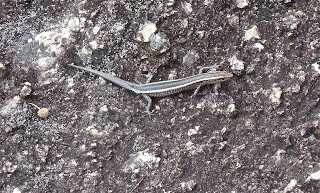The weather forecast wasn't great, and we hit torrential rain just beyond Samford. We stopped for coffee at Dayboro, something of a habit, and from there took Mckenzie Street on to Lacey's Creek Road. We were clear where we were going on the National Park map, but we passed two No Through Road signs, always a tad worrying. Lacy's Creek Road was long and winding and we didn't want to have to turn back the way we'd come. But in the past we've tried to take shortcuts or more interesting off-road routes in the Sunshine Coast Hinterland that were on our Hema map but have been disappeared in reality, we suspect by property owners not well disposed to passers-by.
There were a couple of items of interest along the way.
 |
| Spot my shy companion |
Just as I was anticipating the end of the road, which had become narrow and seemingly rarely used by this stage, we reached the entrance to the National Park.
The track was rocky and steep beyond, with the occasional crazy dirt biker careening down even steeper slopes into our path. Maybe that's why there was this further up the hill.
There were tantalising glimpses of unspoilt hills stretching out west. The blue mountains looked like a summery sky behind the foliage.
The weather was closing in as we climbed higher up into the Range and the clouds.There were tantalising glimpses of unspoilt hills stretching out west. The blue mountains looked like a summery sky behind the foliage.
 |
| The ethereal forest |
Soon we came upon what claimed to be Kluvers Lookout. At first we could only find a phone mast with an impressive solar array and a handful of Red-browed Finches on a wire. Then the mist lifted enough to reveal a valley east of the Range.
Further on, it got more rainforesty. Then there were grass trees; and a fern-covered forest floor.
At the next junction we turned on to Peggs Road, and it wasn't long before we reached The Gantry day-use area. It looked familiar from a previous Australia Day trip – the day of the Mount Mee leech incident, when my friend learned to his cost that Australian leeches lurk in damp undergrowth, not water. We'd thought we might have lunch at The Gantry, but no chance: it was heaving and there was nowhere to park. It takes its name from this.
The enormous shed, built in the 1950s, housed the overhead gantry of a sawmill. The timber industry in the area dates from 1879.
We beat a hasty retreat from the hordes and headed off down the Western Escarpment Forest Drive. One thing we love about drives such as this is the ever-changing forestscape, from open dry eucalypt to rainforest. The variety continued around the Escarpment circuit.
And roughly halfway, after slow progress along a rocky trail, was the Somerset Lookout, with more skinks than you could shake a stick at and an extraordinary caterpillar, as well as the view.
It was a thoroughly enjoyable trip that engendered thoughts befitting of Australia Day*.
* See also That day at the end of Jan, January 2016
This post was last updated on 1 February 2016





























































